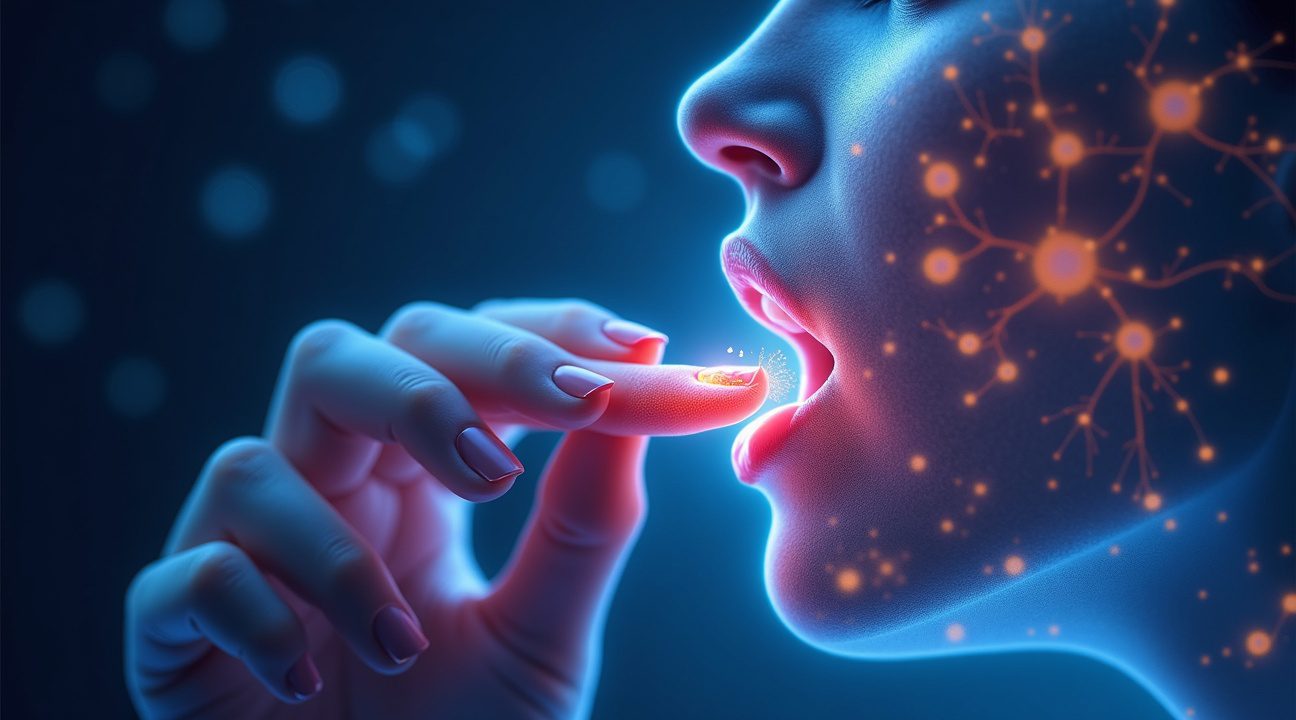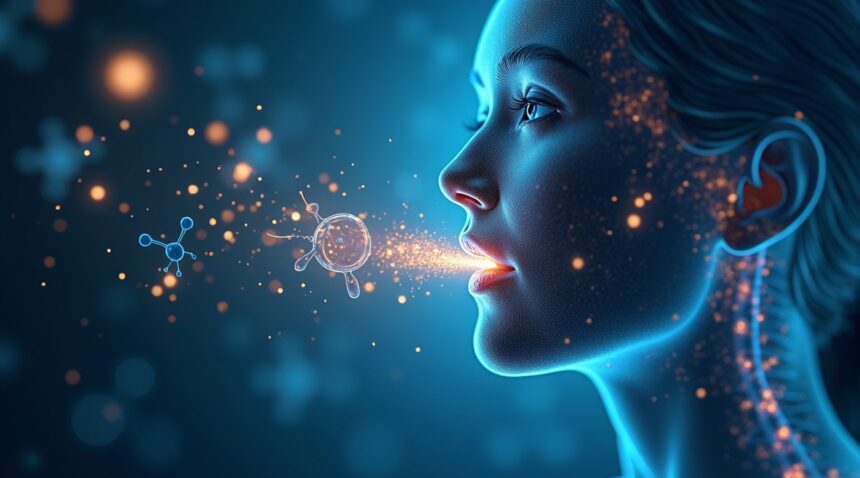Human saliva contains opiorphin, a naturally occurring compound that researchers at the Pasteur Institute discovered possesses six times more potency than morphine in laboratory studies. This remarkable painkiller exists in everyone’s saliva and works by protecting the body’s natural pain-fighting enkephalins, offering a sophisticated biological defense system that operates continuously without conscious effort.
Key Takeaways
- Opiorphin is a pentapeptide found in human saliva that demonstrates pain-blocking capabilities six times stronger than morphine in laboratory tests on rats.
- The compound works by protecting natural enkephalins rather than introducing foreign substances, inhibiting enzymes that would normally break down the body’s existing pain relief system.
- Daily saliva production provides continuous low-level pain management while also responding to injuries with increased opiorphin release for enhanced healing support.
- Research remains in preclinical phases with significant hurdles including the compound’s fragile nature, poor bioavailability, and difficulty crossing the blood-brain barrier for therapeutic applications.
- The “kissing it better” instinct has scientific basis as applying saliva to wounds delivers this natural painkiller directly to injury sites while supporting tissue repair and reducing inflammation.
To learn more about opiorphin, visit this Wikipedia article on Opiorphin.
Scientists Discover a Natural Painkiller Hidden in Your Saliva That’s Six Times Stronger Than Morphine
I find it fascinating that every time someone produces saliva, they’re manufacturing one of nature’s most powerful painkillers. Hidden within this everyday bodily fluid lies opiorphin, a remarkable chemical compound that researchers at the Pasteur Institute in Paris first isolated in 2006. This discovery has revolutionized how scientists understand the body’s natural pain management systems.
The Powerful Chemistry Behind Nature’s Pain Relief
Opiorphin stands as a pentapeptide, which means it’s constructed from a chain of five specific amino acids arranged in the sequence Gln-Arg-Phe-Ser-Arg (QRFSR). Laboratory experiments conducted on rats revealed that this naturally occurring compound demonstrates pain-blocking capabilities up to six times more potent than morphine. The implications of this discovery extend far beyond what most people realize about their body’s inherent pharmaceutical capabilities.
Scientists have observed that opiorphin appears physiologically after painful stimuli, suggesting the body activates this natural defense mechanism when needed most. However, researchers continue investigating its regular role since daily production occurs as a baseline function rather than solely in response to pain. This constant production means every individual carries this powerful endogenous opioid in their mouth throughout the day.
The compound works by interacting with the body’s enkephalin system, which plays a crucial role in natural pain regulation. Unlike synthetic opioids that can cause severe side effects and dependency issues, opiorphin represents the body’s own sophisticated approach to pain management. Its discovery has opened new avenues for understanding how the brain and body collaborate to maintain comfort and well-being.
What makes this discovery particularly intriguing is how the human body has evolved to include such a powerful painkiller in something as routine as saliva production. Just as some people possess extraordinary senses, the presence of opiorphin demonstrates that everyone carries remarkable biological capabilities they’re completely unaware of.
The research conducted at the Pasteur Institute has sparked interest in developing new pain management strategies that could harness or mimic this natural compound. Scientists continue exploring how opiorphin might be utilized therapeutically while maintaining the safety profile that comes with the body’s own production methods.
This groundbreaking discovery reminds us that the human body contains numerous hidden mechanisms designed to protect and heal. The presence of such a potent natural painkiller in saliva highlights the incredible sophistication of our biological systems and their ability to manage pain without external intervention.
The Biochemical Magic: How Opiorphin Amplifies Your Body’s Natural Pain Relief System
I find it remarkable that this compound works by protecting your body’s existing pain-fighting arsenal rather than introducing foreign substances. Opiorphin functions as a biochemical bodyguard, inhibiting specific enzymes called proteases that normally break down enkephalins—your body’s own natural opioids responsible for pain relief. By preventing this breakdown, opiorphin allows enkephalins to remain active much longer, dramatically enhancing your natural pain-blocking effects.
The Enzyme Inhibition Process
The mechanism involves blocking three major protease enzymes that would otherwise rapidly degrade your enkephalins. Opiorphin specifically targets:
- Neutral ecto-endopeptidase (MME)
- Ecto-aminopeptidase N (ANPEP)
- Possibly dipeptidyl peptidase DPP3
Without opiorphin’s protective action, these enzymes would quickly dismantle your enkephalins, leaving you with diminished natural pain relief capacity.
How Natural Pain Relief Actually Works
Once protected by opiorphin, your enkephalins bind to opioid receptors in the spinal cord, effectively blocking transmission of pain signals to the brain. This process mirrors exactly how morphine and other pharmaceutical opioids function, except opiorphin amplifies your body’s existing system rather than overwhelming it with external compounds. I think this distinction explains why natural compounds often work more harmoniously with our physiology.
Because opiorphin strengthens natural pain-blocking systems instead of introducing external opioids, it could potentially sidestep severe side effects like addiction and tolerance commonly associated with morphine. Your body already produces the pain relief—opiorphin simply ensures it lasts longer and works more effectively. Early research data suggest opiorphin may also deliver mood-regulating and anti-anxiety effects due to its role in neuropeptide activity throughout the brain.
The beauty of this system lies in its sophistication. Rather than flooding your system with artificial painkillers, opiorphin works like your brain’s natural processes, supporting and extending what your body already does well. This approach could represent a revolutionary shift in pain management, offering powerful relief while respecting your body’s natural biochemical balance.
Your Body’s Multi-Layered Defense Against Pain: Endorphins and Beyond
I’ve discovered something remarkable about the human body’s pain management system – it operates like a sophisticated pharmacy that never closes. The saliva containing opiorphin represents just one part of an intricate network of natural painkillers working around the clock to protect us from discomfort.
Endorphins serve as another powerful class of pain-fighting compounds that I produce constantly. These natural opioids work hand-in-hand with substances like opiorphin to create a comprehensive defense system against pain. Scientists have identified over 20 different types of endorphins circulating through my body, each with specific roles in pain management and mood regulation.
Beta-Endorphin: The Body’s Strongest Natural Painkiller
Beta-endorphin stands out as the most potent member of this endorphin family. This remarkable compound actually surpasses morphine in its ability to block pain signals, making it one of nature’s most effective analgesics. When I experience injury, stress, or engage in vigorous exercise, my body releases these powerful molecules to help manage discomfort and maintain function.
The effectiveness of these natural compounds becomes particularly evident during intense physical activity. The famous runner’s high that athletes experience results from this natural opioid release. Both endorphins and enkephalins bind to the same opioid receptors that pharmaceutical painkillers target, but they do so without the harmful side effects associated with synthetic alternatives.
My nervous system activates this multi-layered defense automatically during various situations:
- Intense exercise triggers massive endorphin release, which explains why I might feel euphoric after a challenging workout.
- Stress also stimulates production of these natural painkillers, helping me cope with both physical and emotional challenges.
- Laughing can boost endorphin levels, contributing to the healing power of humor.
The discovery of opiorphin adds another dimension to our understanding of natural pain management. This finding reveals that my body doesn’t rely on a single system but instead employs multiple opioid pathways to regulate pain effectively. Each system activates under different circumstances, creating redundancy that ensures pain relief remains available when needed most.
These natural opioids work by interrupting pain signals before they reach my brain. When I stub my toe or experience muscle strain, specialized cells release endorphins and other compounds that bind to opioid receptors along nerve pathways. This binding action effectively blocks pain messages from traveling to my brain, reducing the intensity of discomfort I experience.
The sophistication of this system extends beyond simple pain blocking. These compounds also influence mood, stress response, and even immune function:
- Beta-endorphin can produce feelings of well-being and relaxation.
- Other endorphins help regulate sleep patterns and emotional balance.
This explains why people often report feeling better overall when they maintain active lifestyles or engage in activities that naturally boost endorphin production.
Understanding these natural pain management systems offers valuable insights for maintaining optimal health. Regular exercise not only strengthens muscles and improves cardiovascular health but also keeps my body’s natural painkiller production functioning at peak efficiency. Activities like dancing, swimming, or even brisk walking can stimulate endorphin release, providing both immediate mood benefits and long-term pain management advantages.
The interconnected nature of these systems demonstrates the body’s incredible ability to self-regulate and heal. Opiorphin production continues in my saliva throughout the day, while endorphins stand ready to respond to physical challenges or stress. This constant availability of natural pain relief represents millions of years of evolutionary refinement, creating a system far more sophisticated than any manufactured alternative.
Research continues to reveal new aspects of these natural opioid systems, suggesting that we’ve only begun to understand the full scope of the body’s pain management capabilities. Each discovery reinforces the remarkable fact that I carry within me a complete pharmacy of natural compounds, working continuously to maintain comfort and well-being without any conscious effort on my part.
The Promise and Hurdles of Turning Spit Into Medicine
Scientists are diving deep into opiorphin’s potential as a revolutionary pain medication, but the path from saliva to pharmacy shelves isn’t straightforward. I find it fascinating that this natural compound could offer powerful pain relief with potentially fewer side effects than traditional opioids, yet significant scientific hurdles remain.
Breaking Down the Barriers
The biggest challenge facing researchers involves opiorphin’s fragile nature and delivery problems. The compound breaks down rapidly once inside the body, making it difficult to maintain therapeutic levels for extended periods. Even more problematic, opiorphin struggles to cross the blood-brain barrier effectively, which limits its ability to reach pain centers in the brain when taken orally or through intravenous methods.
Chemical modifications represent the current focus of research efforts. Scientists are working to create synthetic versions that maintain opiorphin’s pain-fighting properties while improving stability and bioavailability. These modifications could potentially solve the delivery challenges that currently prevent clinical applications.
The Long Road to Clinical Reality
Despite opiorphin’s promise, no commercial medications based on this compound exist today. Research remains firmly planted in preclinical and animal testing phases, with human clinical trials still on the horizon. The complexity of moving from laboratory discovery to approved medication involves numerous safety and efficacy hurdles.
Researchers express caution about opiorphin’s broad enzymatic activity. The compound affects multiple enzyme systems simultaneously, which could introduce unexpected side effects that haven’t been fully explored. This multi-target approach might explain its potency, but it also complicates safety assessments and regulatory approval processes.
Comprehensive studies are essential before any opiorphin-based drugs reach patients. Scientists must thoroughly evaluate:
- Long-term effects
- Optimal dosing strategies
- Potential interactions with other medications
The pharmaceutical development process typically spans decades, involving multiple phases of testing to ensure both safety and effectiveness.
Current research shows promise, but translating saliva’s natural painkiller into a viable medication requires solving fundamental chemistry and biology challenges. While I can’t predict when opiorphin-based drugs might reach market, the ongoing research represents an intriguing example of how our bodies already contain extraordinary biological mechanisms that could revolutionize medical treatment. Drug development continues as researchers work to harness this natural compound’s potential while addressing its inherent limitations.

Why ‘Kissing It Better’ Actually Works: The Science Behind Saliva’s Soothing Power
I’ve discovered there’s genuine science behind the age-old practice of “kissing it better.” When someone licks a wound or applies saliva to an injury, they’re actually delivering a powerful natural painkiller called opiorphin. This remarkable compound, present in everyone’s saliva, provides pain relief that’s remarkably effective.
Saliva serves as much more than a digestive aid. Each time someone speaks, chews, or eats, they create microscopic injuries in their mouth. These tiny wounds trigger the body’s protective response, causing increased saliva production loaded with opiorphin. This natural analgesic immediately goes to work, numbing pain and promoting healing at the injury site.
The Body’s Automatic Defense System
The mouth experiences constant trauma throughout daily activities. Biting the tongue, scraping against teeth, or consuming hot foods all create small injuries that could become problematic without proper pain management. Opiorphin steps in as the body’s first line of defense, providing immediate relief while other healing mechanisms activate.
Research shows that opiorphin doesn’t just mask pain—it actively supports the healing process. The compound helps reduce inflammation while encouraging tissue repair, making it an ideal natural remedy for oral injuries. This dual action explains why people instinctively put injured fingers in their mouths or why animals lick their wounds.
Beyond Oral Care: Saliva’s Hidden Benefits
The production of opiorphin isn’t limited to obvious injuries. Even routine activities like talking or eating trigger its release, providing continuous low-level pain management throughout the day. This constant presence helps explain why some people seem to have higher pain tolerance than others—their saliva production might be more robust.
Scientists have found that stress, dehydration, and certain medications can affect opiorphin levels in saliva. People who maintain good oral hygiene and stay properly hydrated tend to have more effective natural pain relief systems. The connection between adequate sleep and pain management also extends to saliva production, as rest helps optimize the body’s natural healing processes.
The implications of this discovery extend beyond understanding why kissing injuries feels soothing. Medical researchers are exploring ways to harness opiorphin’s power for therapeutic applications. Unlike synthetic painkillers, this natural compound doesn’t carry the same risk of dependency or serious side effects.
I find it fascinating that evolution equipped humans with such an effective pain management system right in their mouths. The fact that opiorphin is six times stronger than morphine yet produced naturally every day demonstrates the incredible sophistication of human biology. This built-in pharmacy operates continuously, providing relief and healing support without conscious effort.
The next time someone automatically puts an injured finger to their mouth, they’re following an ancient biological imperative. Their body knows exactly what it’s doing—delivering a powerful, natural painkiller that’s been perfected over millions of years of evolution. This instinctive response represents one of nature’s most elegant solutions to pain management, hiding in plain sight within something as simple as saliva.
Understanding opiorphin’s role also sheds light on why good oral health matters beyond preventing cavities. A healthy mouth produces more effective saliva, which means better natural pain relief and faster healing. This connection between oral hygiene and pain management adds another layer to the importance of maintaining good dental care habits throughout life.

Sources:
Nature – “Scientists Discover a Natural Painkiller Hidden in Your Saliva That’s Six Times Stronger Than Morphine”
Wikipedia – “Opiorphin”
Cleveland Clinic – “Endorphins”
RS Medical – “6 Tips for Boosting Endorphins: The Body’s Natural Painkillers”
University of California, San Francisco (UCSF) – “Body’s Natural Opioids Affect Brain Cells Much Differently Than Morphine”


